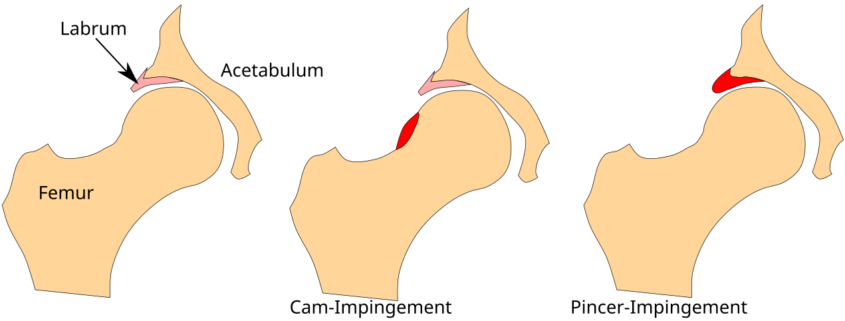
Femoroacetabular Impingement
Overview
Femoroacetabular Impingement (FAI), also known as hip impingement, is a common orthopedic condition involving an abnormally tight fit between the ball and socket of the hip joint. This leads to friction during hip movements, which could over time cause damage to the joint. It is estimated that up to 15% of the population may suffer from some form of FAI, although many cases may go undiagnosed until the damage becomes significant.
Types
There are essentially two types of FAI, which include:
-
- Cam Impingement: This occurs when the femoral head and neck are not perfectly round, leading to abnormal contact between the joint surfaces. This is more common in young find middle-aged men.
-
- Pincer Impingement: This happens when the socket (acetabulum) covers too much of the femoral head, resulting in the labrum being pinched. This type of impingement is more commonly seen in middle-aged women.
Causes
FAI is often caused by an irregular shape of the hip joint which might arise due to several reasons:
-
- Genetic predisposition
-
- Childhood hip disorders
-
- Growth spurts during puberty
-
- Sports or activities involving repetitive hip motion
Symptoms
Common symptoms of FAI include:
-
- Pain and stiffness in the groin or hip area
-
- Pain that worsens during activities such as bending, twisting, or squatting
-
- Reduced hip mobility
Less common or late-stage symptoms can also include:
-
- Persistent pain, even during rest
-
- Limping
-
- Clicking or locking sensation in the hip
Diagnosis
The diagnosis of FAI may involve a series of steps, such as:
-
- Physical examination: This will help determine the range of motion and assess any discomfort or changes in movement.
-
- Imaging Tests: This might include X-rays to show unusual hip shapes or joint damage, Magnetic Resonance Imaging (MRI) to assess soft tissue damage, or a CT scan to provide a more detailed view of the joint.
Treatment Options
FAI can often be managed conservatively with the following approaches:
-
- Physical therapy and exercises
-
- Pain management with medication
-
- Activity modification
-
- Injections
If symptoms persist or the condition deteriorates, surgical treatments may be considered. This includes:
-
- Arthroscopy: A minimally invasive procedure where small cameras and tools are inserted through small incisions to shave or repair the joint.
-
- Osteoplasty: Reshaping the femoral head to improve fit within the socket.
-
- Ligament repairs or replacement
Living With Femoroacetabular Impingement
Here are practical tips on managing Femoroacetabular Impingement:
-
- Stay active with low-impact exercises like swimming, biking, or elliptical machines.
-
- Maintain a healthy weight to reduce stress on hips.
-
- Use Non-Steroidal Anti-Inflammatory Drugs (NSAIDs) to manage pain.
-
- Follow a healthy diet and consider supplements for bone health.
-
- Keep up a regular physical therapy routine.
-
- Manage pain with hot or cold therapy.
When to Seek Help
If you experience any of the following, it’s essential to seek immediate medical attention:
-
- Persistent or worsened hip or groin pain despite medication
-
- Increased difficulties with mobility or daily activities
-
- New or worsened symptoms of clicking, locking, or instability in your hip
Remember, early intervention can prevent further joint damage and enhance the quality of life. Aim to maintain proper communication with your healthcare provider and report any changes in your condition promptly.
